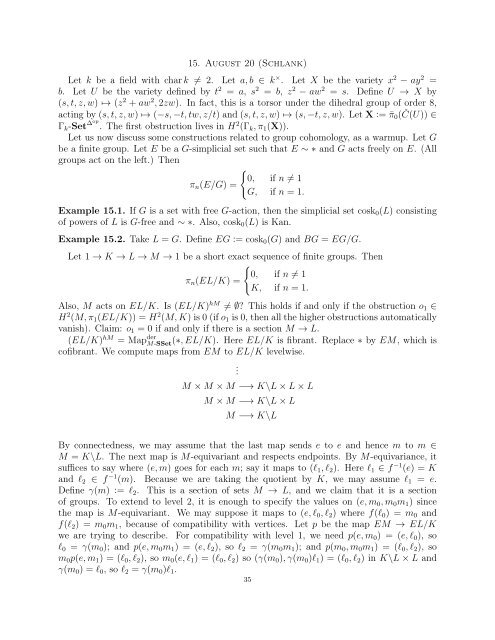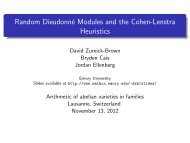alternative lecture notes - Rational points and algebraic cycles
alternative lecture notes - Rational points and algebraic cycles
alternative lecture notes - Rational points and algebraic cycles
Create successful ePaper yourself
Turn your PDF publications into a flip-book with our unique Google optimized e-Paper software.
15. August 20 (Schlank)<br />
Let k be a field with char k ≠ 2. Let a, b ∈ k × . Let X be the variety x 2 − ay 2 =<br />
b. Let U be the variety defined by t 2 = a, s 2 = b, z 2 − aw 2 = s. Define U → X by<br />
(s, t, z, w) ↦→ (z 2 + aw 2 , 2zw). In fact, this is a torsor under the dihedral group of order 8,<br />
acting by (s, t, z, w) ↦→ (−s, −t, tw, z/t) <strong>and</strong> (s, t, z, w) ↦→ (s, −t, z, w). Let X := ¯π 0 (Č(U)) ∈<br />
Γ k -Set ∆op . The first obstruction lives in H 2 (Γ k , π 1 (X)).<br />
Let us now discuss some constructions related to group cohomology, as a warmup. Let G<br />
be a finite group. Let E be a G-simplicial set such that E ∼ ∗ <strong>and</strong> G acts freely on E. (All<br />
groups act on the left.) Then<br />
{<br />
0, if n ≠ 1<br />
π n (E/G) =<br />
G, if n = 1.<br />
Example 15.1. If G is a set with free G-action, then the simplicial set cosk 0 (L) consisting<br />
of powers of L is G-free <strong>and</strong> ∼ ∗. Also, cosk 0 (L) is Kan.<br />
Example 15.2. Take L = G. Define EG := cosk 0 (G) <strong>and</strong> BG = EG/G.<br />
Let 1 → K → L → M → 1 be a short exact sequence of finite groups. Then<br />
{<br />
0, if n ≠ 1<br />
π n (EL/K) =<br />
K, if n = 1.<br />
Also, M acts on EL/K. Is (EL/K) hM ≠ ∅? This holds if <strong>and</strong> only if the obstruction o 1 ∈<br />
H 2 (M, π 1 (EL/K)) = H 2 (M, K) is 0 (if o 1 is 0, then all the higher obstructions automatically<br />
vanish). Claim: o 1 = 0 if <strong>and</strong> only if there is a section M → L.<br />
(EL/K) hM = Map der<br />
M-SSet(∗, EL/K). Here EL/K is fibrant. Replace ∗ by EM, which is<br />
cofibrant. We compute maps from EM to EL/K levelwise.<br />
.<br />
M × M × M −→ K\L × L × L<br />
M × M −→ K\L × L<br />
M −→ K\L<br />
By connectedness, we may assume that the last map sends e to e <strong>and</strong> hence m to m ∈<br />
M = K\L. The next map is M-equivariant <strong>and</strong> respects end<strong>points</strong>. By M-equivariance, it<br />
suffices to say where (e, m) goes for each m; say it maps to (l 1 , l 2 ). Here l 1 ∈ f −1 (e) = K<br />
<strong>and</strong> l 2 ∈ f −1 (m). Because we are taking the quotient by K, we may assume l 1 = e.<br />
Define γ(m) := l 2 . This is a section of sets M → L, <strong>and</strong> we claim that it is a section<br />
of groups. To extend to level 2, it is enough to specify the values on (e, m 0 , m 0 m 1 ) since<br />
the map is M-equivariant. We may suppose it maps to (e, l 0 , l 2 ) where f(l 0 ) = m 0 <strong>and</strong><br />
f(l 2 ) = m 0 m 1 , because of compatibility with vertices. Let p be the map EM → EL/K<br />
we are trying to describe. For compatibility with level 1, we need p(e, m 0 ) = (e, l 0 ), so<br />
l 0 = γ(m 0 ); <strong>and</strong> p(e, m 0 m 1 ) = (e, l 2 ), so l 2 = γ(m 0 m 1 ); <strong>and</strong> p(m 0 , m 0 m 1 ) = (l 0 , l 2 ), so<br />
m 0 p(e, m 1 ) = (l 0 , l 2 ), so m 0 (e, l 1 ) = (l 0 , l 2 ) so (γ(m 0 ), γ(m 0 )l 1 ) = (l 0 , l 2 ) in K\L × L <strong>and</strong><br />
γ(m 0 ) = l 0 , so l 2 = γ(m 0 )l 1 .<br />
35



